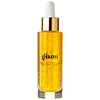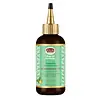What's inside
What's inside
 Key Ingredients
Key Ingredients

 Benefits
Benefits

 Concerns
Concerns

 Ingredients Side-by-side
Ingredients Side-by-side

Water
Skin ConditioningPropanediol
SolventCoco-Caprylate/Caprate
EmollientBetaine
HumectantCaprylic/Capric Triglyceride
MaskingPentylene Glycol
Skin ConditioningMel
EmollientPropolis Cera
AntiseborrhoeicLimnanthes Alba Seed Oil
Skin ConditioningVitis Vinifera Seed Oil
EmollientCarthamus Tinctorius Seed Oil
MaskingHelianthus Annuus Seed Oil
EmollientHydrolyzed Pea Protein
EmollientHydrolyzed Vegetable Protein
Skin ConditioningHippophae Rhamnoides Oil
EmollientOenothera Biennis Oil
EmollientRosa Canina Fruit Oil
EmollientTocopherol
AntioxidantCalendula Officinalis Flower Extract
MaskingHelianthus Annuus Sprout Extract
Skin ConditioningCaesalpinia Spinosa Fruit Pod Extract
Daucus Carota Sativa Root Extract
Skin ConditioningCitrus Aurantium Bergamia Fruit Extract
Skin ConditioningParfum
MaskingCastor Oil/Ipdi Copolymer
Maltodextrin
AbsorbentAcrylates/C10-30 Alkyl Acrylate Crosspolymer
Emulsion StabilisingChlorphenesin
AntimicrobialCarbomer
Emulsion StabilisingSodium Hydroxide
BufferingTrisodium Ethylenediamine Disuccinate
Acacia Senegal Gum
MaskingXanthan Gum
EmulsifyingTamarindus Indica Seed Gum
Emulsion StabilisingPotassium Sorbate
PreservativeSodium Benzoate
MaskingGlucose
HumectantCI 40800
Cosmetic ColorantLimonene
PerfumingLinalool
PerfumingHexyl Cinnamal
PerfumingCoumarin
PerfumingWater, Propanediol, Coco-Caprylate/Caprate, Betaine, Caprylic/Capric Triglyceride, Pentylene Glycol, Mel, Propolis Cera, Limnanthes Alba Seed Oil, Vitis Vinifera Seed Oil, Carthamus Tinctorius Seed Oil, Helianthus Annuus Seed Oil, Hydrolyzed Pea Protein, Hydrolyzed Vegetable Protein, Hippophae Rhamnoides Oil, Oenothera Biennis Oil, Rosa Canina Fruit Oil, Tocopherol, Calendula Officinalis Flower Extract, Helianthus Annuus Sprout Extract, Caesalpinia Spinosa Fruit Pod Extract, Daucus Carota Sativa Root Extract, Citrus Aurantium Bergamia Fruit Extract, Parfum, Castor Oil/Ipdi Copolymer, Maltodextrin, Acrylates/C10-30 Alkyl Acrylate Crosspolymer, Chlorphenesin, Carbomer, Sodium Hydroxide, Trisodium Ethylenediamine Disuccinate, Acacia Senegal Gum, Xanthan Gum, Tamarindus Indica Seed Gum, Potassium Sorbate, Sodium Benzoate, Glucose, CI 40800, Limonene, Linalool, Hexyl Cinnamal, Coumarin
Glycine Soja Oil
EmollientRicinus Communis Seed Oil
MaskingMentha Piperita Oil
MaskingRosmarinus Officinalis Stem Oil
PerfumingCocos Nucifera Oil
MaskingOlea Europaea Fruit Oil
MaskingVitis Vinifera Seed Oil
EmollientC12-15 Alkyl Benzoate
AntimicrobialSalvia Officinalis Oil
MaskingEucalyptus Globulus Leaf Oil
PerfumingArgania Spinosa Kernel Oil
EmollientPersea Gratissima Oil
Skin ConditioningMelaleuca Alternifolia Leaf Oil
AntioxidantPrunus Amygdalus Dulcis Oil
Skin ConditioningHelianthus Annuus Seed Oil
EmollientSimmondsia Chinensis Seed Oil
EmollientParfum
MaskingVegetable Oil
Skin ConditioningTocopherol
AntioxidantLimonene
PerfumingBenzyl Salicylate
PerfumingHydroxycitronellal
PerfumingCitronellol
PerfumingCoumarin
PerfumingAlpha-Isomethyl Ionone
PerfumingLinalool
PerfumingGlycine Soja Oil, Ricinus Communis Seed Oil, Mentha Piperita Oil, Rosmarinus Officinalis Stem Oil, Cocos Nucifera Oil, Olea Europaea Fruit Oil, Vitis Vinifera Seed Oil, C12-15 Alkyl Benzoate, Salvia Officinalis Oil, Eucalyptus Globulus Leaf Oil, Argania Spinosa Kernel Oil, Persea Gratissima Oil, Melaleuca Alternifolia Leaf Oil, Prunus Amygdalus Dulcis Oil, Helianthus Annuus Seed Oil, Simmondsia Chinensis Seed Oil, Parfum, Vegetable Oil, Tocopherol, Limonene, Benzyl Salicylate, Hydroxycitronellal, Citronellol, Coumarin, Alpha-Isomethyl Ionone, Linalool
Ingredients Explained
These ingredients are found in both products.
Ingredients higher up in an ingredient list are typically present in a larger amount.
Coumarins are a group of substances found naturally in plants. There are over 1300 types of coumarins identified. It has a natural vanilla scent.
Coumarin is an identified EU known allergy, meaning it may cause an allergic reaction when applied to the skin.
In many countries, coumarin is banned as a food additive. However, it can be found in soaps, tobacco products, and some alcohol drinks.
Plants use coumarins as a chemical defense. Some plants that have coumarins include lavender, tonka beans, and yellow clovers.
Learn more about CoumarinHelianthus Annuus Seed Oil is the oil derived from the seeds of a Sunflower. Sunflower seed oil is non-fragrant. It is an emollient, meaning it helps to soften the skin.
Sunflower seed oil contains many fatty acids. The fatty acids found in sunflower seeds include (from highest amount to least): linoleic acid, myristic acid, palmitic acid, stearic acid, arachidic acid, oleic acid, and linolenic acid.
These fatty acids help the skin create ceramides. Ceramides play a role in repairing the skin barrier.
Helianthus Annuus Seed Oil helps moisturize the skin. This in turn helps the skin look more rejuvenated and smoother.
Sunflowers are rich in vitamin E.
Historians believe Indigenous cultures of North America domesticated sunflowers before corn. Thus they relied on sunflower oil for a variety of uses. One such use is moisturizing skin and hair.
Sunflower seed oil may not be fungal acne safe. We recommend speaking with a professional if you have any concerns.
Learn more about Helianthus Annuus Seed OilLimonene is a fragrance that adds scent and taste to a formulation.
It's found in the peel oil of citrus fruits and other plants such as lavender and eucalyptus. The scent of limonene is generally described as "sweet citrus".
Limonene acts as an antioxidant, meaning it helps neutralize free radicals.
When exposed to air, oxidized limonene may sensitize the skin. Because of this, limonene is often avoided by people with sensitive skin.
The term 'fragrance' is not regulated in many countries. In many cases, it is up to the brand to define this term. For instance, many brands choose to label themselves as "fragrance-free" because they are not using synthetic fragrances. However, their products may still contain ingredients such as essential oils that are considered a fragrance.
Learn more about LimoneneLinalool is a fragrance and helps add scent to products. It's derived from common plants such as cinnamon, mint, citrus, and lavender.
Like Limonene, this ingredient oxidizes when exposed to air. Oxidized linalool can cause allergies and skin sensitivity.
This ingredient has a scent that is floral, spicy tropical, and citrus-like.
Learn more about LinaloolParfum is a catch-all term for an ingredient or more that is used to give a scent to products.
Also called "fragrance", this ingredient can be a blend of hundreds of chemicals or plant oils. This means every product with "fragrance" or "parfum" in the ingredients list is a different mixture.
For instance, Habanolide is a proprietary trade name for a specific aroma chemical. When used as a fragrance ingredient in cosmetics, most aroma chemicals fall under the broad labeling category of “FRAGRANCE” or “PARFUM” according to EU and US regulations.
The term 'parfum' or 'fragrance' is not regulated in many countries. In many cases, it is up to the brand to define this term.
For instance, many brands choose to label themselves as "fragrance-free" because they are not using synthetic fragrances. However, their products may still contain ingredients such as essential oils that are considered a fragrance by INCI standards.
One example is Calendula flower extract. Calendula is an essential oil that still imparts a scent or 'fragrance'.
Depending on the blend, the ingredients in the mixture can cause allergies and sensitivities on the skin. Some ingredients that are known EU allergens include linalool and citronellol.
Parfum can also be used to mask or cover an unpleasant scent.
The bottom line is: not all fragrances/parfum/ingredients are created equally. If you are worried about fragrances, we recommend taking a closer look at an ingredient. And of course, we always recommend speaking with a professional.
Learn more about ParfumTocopherol (also known as Vitamin E) is a common antioxidant used to help protect the skin from free-radicals and strengthen the skin barrier. It's also fat soluble - this means our skin is great at absorbing it.
Vitamin E also helps keep your natural skin lipids healthy. Your lipid skin barrier naturally consists of lipids, ceramides, and fatty acids. Vitamin E offers extra protection for your skin’s lipid barrier, keeping your skin healthy and nourished.
Another benefit is a bit of UV protection. Vitamin E helps reduce the damage caused by UVB rays. (It should not replace your sunscreen). Combining it with Vitamin C can decrease sunburned cells and hyperpigmentation after UV exposure.
You might have noticed Vitamin E + C often paired together. This is because it is great at stabilizing Vitamin C. Using the two together helps increase the effectiveness of both ingredients.
There are often claims that Vitamin E can reduce/prevent scarring, but these claims haven't been confirmed by scientific research.
Learn more about TocopherolVitis Vinifera Seed Oil comes from the grape vine. Grape seeds are a byproduct of creating grape juice or wine.
The components of grape seeds have many skin benefits. Research has found it to be antimicrobial and anti-inflammatory. It also contains many potent antioxidants such as Vitamin E , Vitamin C, proanthocyanidins, polyphenols, flavonoids, and anthocyanins. Proanthocyanidin has been shown to help even out skin tone.
Antioxidants help fight free-radical molecules. Free-radical molecules are capable of damaging our cells and other genetic material. Antioxidants help stabilize free-radicals by donating extra electrons. Grape seed extract may help reduce the signs of aging.
The antimicrobial properties of grape seed may help treat acne. However, more research is needed to support this claim.
Grape seed has also been found to help absorb UV rays. Grape seed extract should not replace your sunscreen.
The fatty acids of grape seed oil give it emollient properties. Emollients help soothe and soften your skin by creating a film. This film traps moisture within, keeping your skin hydrated.
Learn more about Vitis Vinifera Seed Oil